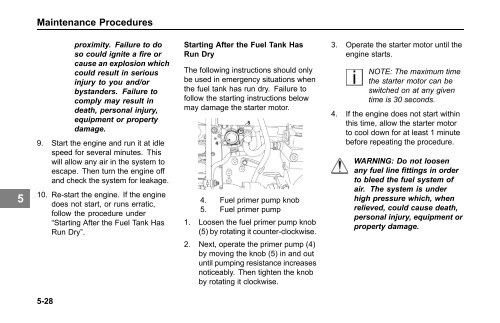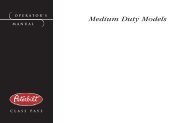C - Peterbilt Motors Company
C - Peterbilt Motors Company
C - Peterbilt Motors Company
You also want an ePaper? Increase the reach of your titles
YUMPU automatically turns print PDFs into web optimized ePapers that Google loves.
5<br />
Maintenance Procedures<br />
proximity. Failure to do<br />
so could ignite a fire or<br />
cause an explosion which<br />
could result in serious<br />
injury to you and/or<br />
bystanders. Failure to<br />
comply may result in<br />
death, personal injury,<br />
equipment or property<br />
damage.<br />
9. Start the engine and run it at idle<br />
speed for several minutes. This<br />
will allow any air in the system to<br />
escape. Then turn the engine off<br />
and check the system for leakage.<br />
10. Re-start the engine. If the engine<br />
does not start, or runs erratic,<br />
follow the procedure under<br />
“Starting After the Fuel Tank Has<br />
Run Dry”.<br />
5-28<br />
Starting After the Fuel Tank Has<br />
Run Dry<br />
The following instructions should only<br />
be used in emergency situations when<br />
the fuel tank has run dry. Failure to<br />
follow the starting instructions below<br />
may damage the starter motor.<br />
4. Fuel primer pump knob<br />
5. Fuel primer pump<br />
1. Loosen the fuel primer pump knob<br />
(5) by rotating it counter-clockwise.<br />
2. Next, operate the primer pump (4)<br />
by moving the knob (5) in and out<br />
until pumping resistance increases<br />
noticeably. Then tighten the knob<br />
by rotating it clockwise.<br />
3. Operate the starter motor until the<br />
engine starts.<br />
NOTE: The maximum time<br />
the starter motor can be<br />
switched on at any given<br />
time is 30 seconds.<br />
4. If the engine does not start within<br />
this time, allow the starter motor<br />
to cool down for at least 1 minute<br />
before repeating the procedure.<br />
WARNING: Do not loosen<br />
any fuel line fittings in order<br />
to bleed the fuel system of<br />
air. The system is under<br />
high pressure which, when<br />
relieved, could cause death,<br />
personal injury, equipment or<br />
property damage.

















